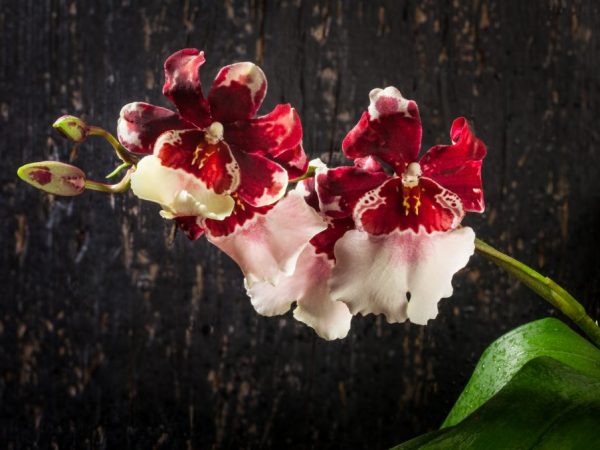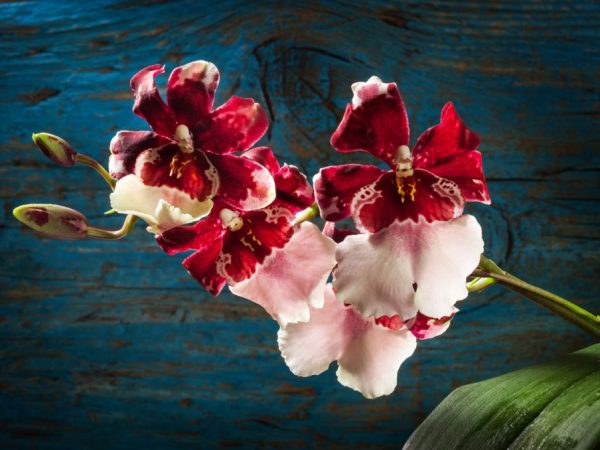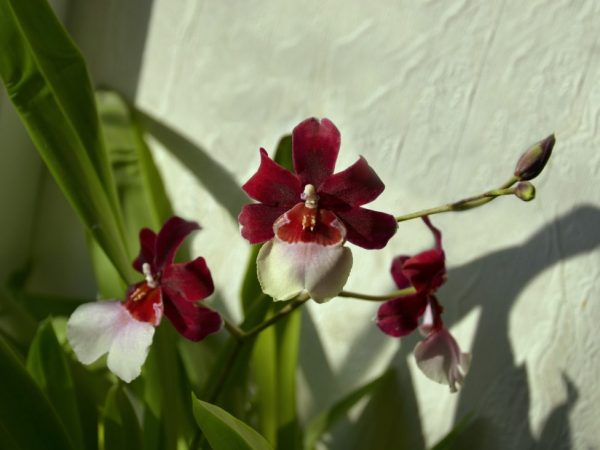Cumbria orchid cultivation
The Cumbria hybrid orchid is a flower from the Orchid family. The bred hybrid is suitable for growing at home. This is an easy-to-care crop that needs to be watered and replanted in a timely manner.

Cumbria orchid cultivation
Description of the variety
The Cambria Orchid is a sympathetic flower. The shape of the bud is oblong, and the total length is not less than 8 cm. For each bud, 2-3 leaves grow, from 40 to 50 cm long. The leaves are wide and densely located to each other. This structure of the leaves allows you to create a beautiful bush that grows quickly. Leaves are bright green with small veins.
The bulb blooms once a year.
Flowering processes are formed on the stem, which are removed after flowering. The flowers are massive: up to 10 cm in diameter. The color is mainly red with small white spots. Flowers of yellow or brown color are less common.
Orchid variety
The Cambria orchid has several species. They are hybrids that adapt to environmental conditions. The most popular varieties:
- Cattleya;
- Tiger;
- Brassia (spider orchid with long shoots on a flower);
- Burrageara;
- Miltonia;
- Cascade;
- Orchid mix;
- Colmanara.
Each orchid variety has its own color and its own structure of petals. Flowers with a rose scent called Burrageara of a pale pink hue. The variety blooms in January. Colmanara blooms from 1 to 3 months: the color of the petals is either red or orange. In Cattleya, the size of flowers with a stem is from 20 cm to 1 m. The color range of the variety is varied - this type is called royal. The tiger variety has a bright color: on the petals there are multiple spots that resemble the color of a tiger. Miltonia is one of the most popular, but whimsical varieties. It has velvety purple flowers. Miltonia blooms at any time of the year.
Growing a flower culture
The orchid is grown at home. Reproduction of culture in most cases is carried out by dividing the bush part. When planting, the bulbs are separated from each other. It is important not to damage the root system. If reproduction ended in damage to the bush, the remaining bulb is treated with activated carbon - this way the rhizome will be protected from infections.
Reproduction of the plant occurs in the warm season, when the young stem quickly takes root. Until the seated bulbs have taken root, they are reinforced with support. Any stick that is previously disinfected is suitable as a support. The first watering or other care procedure is carried out no earlier than a week after planting.
Disembarkation stages
Plants reproduce in different ways. The most popular way is to divide the bush, which is carried out in early spring, when the orchid starts up new bores. They are transplanted into fertilized soil and are well watered. Other types of disembarkation:
- with the help of a seedling;
- dividing the bush.
The root planting method (dividing the bush) is not only the easiest, but also the cheapest. The separated roots are carefully cleaned and processed with wood powder. After that, the planting material takes root. The roots are detached with an ordinary knife, after which the cut site is processed. The material sits in a pot with a substrate. Additionally, the new bore is sprayed with water. The shoots should be at least 3-5 cm. The pot should have drainage layers or holes so that the water does not stagnate.
For planting a culture using a seedling, a purchased flask with planting material is used. The flask is broken, the planting material is washed and soaked in a solution of potassium permanganate. After cleaning, the seedling is dried and planted in a special nutrient substrate. The planting material is immediately cared for.
Home care

The plant needs a lot of attention
The Cambria Orchid is a plant that needs regular maintenance:
- choosing the right place for growing - a well-lit part of the room or a window sill;
- watering;
- fertilization of the soil;
- transfer.
Caring for an orchid without fail includes the treatment of the diseased part of the plant. Watering and fertilization depends on the season: in winter, the flower needs easier care. Any types of flowering plants need processing and fertilization of the soil - the substances introduced into the upper layers of the soil and the drainage installed during planting ensure the rapid growth of the crop.
Lighting mode
At home, Cambria needs proper lighting. This is a light-loving plant: it grows faster in well-lit rooms, and more often withers in the shade. You can not leave the flower unprotected, direct sunlight is also dangerous for the variety. If they stop in the open sun, burns will appear on the leaves and flower. The best option for the correct growth of the flower is a window covered with gauze on the south side of the building. If it is not possible to transfer the culture closer to the south side, the pot is rearranged to the west side, but with additional fertilization.
Winter care includes the organization of additional lighting. Phytolamps are used. With their help, daylight hours are extended to 10-12 hours. Before and after flowering, the culture does not need an additional lighting regime. All Cambria species need a constant source of light during flowering.
Watering
Keeping orchids at home is not complete without moistening the soil. The first watering is carried out after a week of growth of the seedling. Until the first descents appear, if the plant was planted not with a ready-made seedling, but with a bulb, there is no need to water the culture.
Watering during the growth of the stem increases, especially during the ripening of the pseudobulb. As soon as the first inflorescence appears, watering is reduced. After flowering, the amount of moisture is measured as the topsoil dries out. In winter, Cumbria has a dormant period when watering is carried out once a month - a plant whose processes are slowed down does not consume more moisture.
Watering resumes in spring, when the plant starts growing again. After the new shoots are above 3 cm, care (including watering) becomes regular. Between watering, the upper layers of the soil should dry out well, otherwise the root system will rot. If there is no drainage in the pot, you need to be careful with watering: you should not allow water to ferment in the soil. Proper maintenance involves immersing the pot in a container of water - this is the most effective watering method.
Air humidity
Cumbria is demanding of humidity in the room where it grows. In addition to watering at home, additional air humidification is organized. It is especially important to carry out such work if the place where the pot stands is located near the heating systems.
If it is not possible to spray the air every 2-3 days, a water tank is installed next to the pot.With the help of such a device, it will be possible to maintain the desired level of humidity. In the summer, when the moisture evaporates quickly, it is useful to spray the plant with purified water from a spray bottle - you cannot spray the leaves, but only the stem and root part of the flower.
Fertilizing the soil
The soil in which the orchid grows is a source of nutrients. Without constant feeding, the soil is quickly depleted, and the plant dies. Ground handling includes:
- the substrate is fertilized during the formation of pseudobulbs;
- during the flowering period, fertilizers are not applied to the soil;
- after flowering and in early spring, mineral fertilizers are applied with a minimum concentration of active substances.
The maintenance of a flowering culture is not complete without root and foliar dressing. To carry out root dressing, nutrients are added to a container of water, which moistens the soil - a pot with holes in the bottom is immersed in it. Such feeding is carried out once a month, and during the period of illness, 2 times a month. An excessive amount of fertilizer applied to the soil does not benefit the variety, therefore, it is impossible to violate the feeding scheme.
Variety transplant
The most important stage of care is the transplanting of an adult plant. Such an event is held when the orchid has bloomed several times, and the size of the pot no longer corresponds to the overgrown root system. Better to transplant Cambria in the 3rd year of active growth. If the flower is sick, you cannot change the pot. A transplant is necessary if the soil becomes too saline - in such conditions the orchid does not grow, and it is ineffective to introduce new fertilizers into the old substrate.
It is easier to care for a transplanted crop. The transplant is carried out in early spring before the formation of a pseudobulb. The transplant is carried out into a new pot. A container is selected a few cm wider in diameter. You cannot plant an orchid in a pot that is too large, otherwise the root system will be exhausted. Better to choose a ceramic or plastic pot. The transplant is carried out into prepared soil. Fertilized soil (purchased) with a medium fraction is used. The transplant is carried out with a new drainage - tree bark is used for better moisture absorption.
Flowering plant

Cambria blooms in good light
Cumbria bloom in the middle of autumn. If crops have little light, they bloom closer to winter. After the appearance of the first inflorescences, lighting improves - this is a prerequisite for the further development of the orchid. If the plants do not bloom for more than 2 years, their growth is stimulated: watering is reduced during the formation of a pseudobulb. After that, watering does not resume for another 2 weeks.
Post-flowering care
You need to be careful with an orchid after flowering: the plant is weak and often sick. Water the hybrid less as soon as the last petals fall. During this period, you can move the pot (if the inflorescence has not fallen, it is better not to move it). The winter content of the flower is minimal: watering and airing the room.
Difficulties in growing
If the appearance of the flower does not match the state of a healthy plant, in most cases the reason lies in inappropriate care. The problem is either improper watering or a lack of lighting. To find the cause of the poor condition of the plant, you need to change the usual care and fertilizers that are applied to the soil.
If the leaves turn yellow, the root system decays. This situation occurs when water is stagnant in the ground. Excess moisture is a favorable environment for the reproduction of pathogenic microorganisms (fungus). As soon as the flower or leaf turns yellow, you need to dry the plant well. For this, the plant is taken out of the pot and left in a dry room for a day. Before transplanting, the plant is treated with fungicide: only after treatment, the root system returns to the substrate.
If the dry leaves are too damaged, they must be removed. If the soil is lacking in nutrients, yellow spots may also appear.In this case, the situation will improve if you change the nutrients. If the culture sheds yellowed leaves in the autumn, this is a normal phenomenon necessary for the renewal of the green part of the plant. Yellow spots may appear due to sunburn. In this case, the orchid pot needs to be moved to another location.
Diseases and pests
Diseases
Cumbria suffers from fungal diseases that threaten all domestic crops. The risk of such a disease increases if the pot does not have drainage, and the culture is often flooded with water. Fragile Cambria to bacterial infections. These diseases can lead to the death of the adult stem.
Symptoms of the disease that should not be ignored:
- leaves or flowers turn yellow;
- the stem dries up;
- only the leaves begin to fade;
- pseudobulbs are not formed.
Cumbria can become infected with fungal diseases or infections from other crops that grow in the neighborhood. It is necessary to exclude contact with a diseased plant.
Pests
Infectious diseases are carried by pests that attack the plant. Insects harm the plant:
- worm;
- thrips;
- spider mite;
- whitefly.
The worm appears on the plant at any time of the year: it is a small insect that looks like a fluffy white lump - it is easy to miss it. To fight the worms, it is necessary to treat the plant with soapy water. Beer or regular alcohol is suitable for processing. If a whitefly damages the plant, whose larvae suck all the juices from the flower, the green part of the plant is treated with a soapy solution.
Thrips are insects that can penetrate the root of the plant. Actellik's solution will help to make them disappear (treatment is carried out once a week). The spider mite eats the green part of the plant, after which holes appear on the leaves. To combat them, acaricides are used - treatment is carried out at intervals of a week.
Conclusion
An orchid is a beautiful plant that does not require a lot of money to buy. Cambria is a bred variety that takes root well in any room. A shoot or bulb sits down, and then regular care is established, which will allow the plant to bloom once a year.


